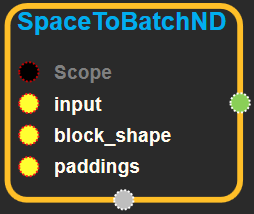SpaceToBatchND
tensorflow C++ API
ensorflow::ops::SpaceToBatchND
SpaceToBatch for N-D tensors of type T.
Summary
This operation divides "spatial" dimensions[1, ..., M]of the input into a grid of blocks of shapeblock_shape, and interleaves these blocks with the "batch" dimension (0) such that in the output, the spatial dimensions[1, ..., M]correspond to the position within the grid, and the batch dimension combines both the position within a spatial block and the original batch position. Prior to division into blocks, the spatial dimensions of the input are optionally zero padded according topaddings. See below for a precise description.
Arguments:
- scope: A Scope object
- input: N-D with shape
input_shape = [batch] + spatial_shape + remaining_shape, where spatial_shape hasMdimensions. - block_shape: 1-D with shape
[M], all values must be >= 1. - paddings: 2-D with shape
[M, 2], all values must be >= 0.paddings[i] = [pad_start, pad_end]specifies the padding for input dimensioni + 1, which corresponds to spatial dimensioni. It is required thatblock_shape[i]dividesinput_shape[i + 1] + pad_start + pad_end.
This operation is equivalent to the following steps:
- Zero-pad the start and end of dimensions
[1, ..., M]of the input according topaddingsto producepaddedof shapepadded_shape. - Reshape
paddedtoreshaped_paddedof shape:[batch] + [padded_shape[1] / block_shape[0], block_shape[0], ..., padded_shape[M] / block_shape[M-1], block_shape[M-1]] + remaining_shape - Permute dimensions of
reshaped_paddedto producepermuted_reshaped_paddedof shape:block_shape + [batch] + [padded_shape[1] / block_shape[0], ..., padded_shape[M] / block_shape[M-1]] + remaining_shape - Reshape
permuted_reshaped_paddedto flattenblock_shapeinto the batch dimension, producing an output tensor of shape:[batch * prod(block_shape)] + [padded_shape[1] / block_shape[0], ..., padded_shape[M] / block_shape[M-1]] + remaining_shape
Some examples:
(1) For the following input of shape[1, 2, 2, 1],block_shape = [2, 2], andpaddings = [[0, 0], [0, 0]]:
``` x = [[[[1], [2]], [[3], [4]]]] ```
The output tensor has shape[4, 1, 1, 1]and value:
``` [[[[1]]], [[[2]]], [[[3]]], [[[4]]]] ```
(2) For the following input of shape[1, 2, 2, 3],block_shape = [2, 2], andpaddings = [[0, 0], [0, 0]]:
``` x = [[[[1, 2, 3], [4, 5, 6]], [[7, 8, 9], [10, 11, 12]]]] ```
The output tensor has shape[4, 1, 1, 3]and value:
``` [[[1, 2, 3]], [[4, 5, 6]], [[7, 8, 9]], [[10, 11, 12]]] ```
(3) For the following input of shape[1, 4, 4, 1],block_shape = [2, 2], andpaddings = [[0, 0], [0, 0]]:
``` x = [[[[1], [2], [3], [4]], [[5], [6], [7], [8]], [[9], [10], [11], [12]], [[13], [14], [15], [16]]]] ```
The output tensor has shape[4, 2, 2, 1]and value:
``` x = [[[[1], [3]], [[9], [11]]], [[[2], [4]], [[10], [12]]], [[[5], [7]], [[13], [15]]], [[[6], [8]], [[14], [16]]]] ```
(4) For the following input of shape[2, 2, 4, 1], block_shape =[2, 2], and paddings =[[0, 0], [2, 0]]:
``` x = [[[[1], [2], [3], [4]], [[5], [6], [7], [8]]], [[[9], [10], [11], [12]], [[13], [14], [15], [16]]]] ```
The output tensor has shape[8, 1, 3, 1]and value:
``` x = [[[[0], [1], [3]]], [[[0], [9], [11]]], [[[0], [2], [4]]], [[[0], [10], [12]]], [[[0], [5], [7]]], [[[0], [13], [15]]], [[[0], [6], [8]]], [[[0], [14], [16]]]] ```
Among others, this operation is useful for reducing atrous convolution into regular convolution.
Returns:
Output: The output tensor.
SpaceToBatchND block
Source link :https://github.com/EXPNUNI/enuSpaceTensorflow/blob/master/enuSpaceTensorflow/tf_array_ops.cpp

Argument:
- Scope scope : A Scope object (A scope is generated automatically each page. A scope is not connected.)
- Input
input: N-D with shapeinput_shape = [batch] + spatial_shape + remaining_shape, where spatial_shape hasMdimensions. - Input
block_shape: 1-D with shape[M], all values must be >= 1. - Input
paddings: 2-D tensor of non-negative integers with shape[M, 2]
Output:
- Output output: Output object of SpaceToBatchND class object.
Result:
- std::vector(Tensor)
result_output: The output tensor.
Using Method

※ N차원의 input 을 재배치하는 기능을 한다. summary의 공식대로 진행된다.